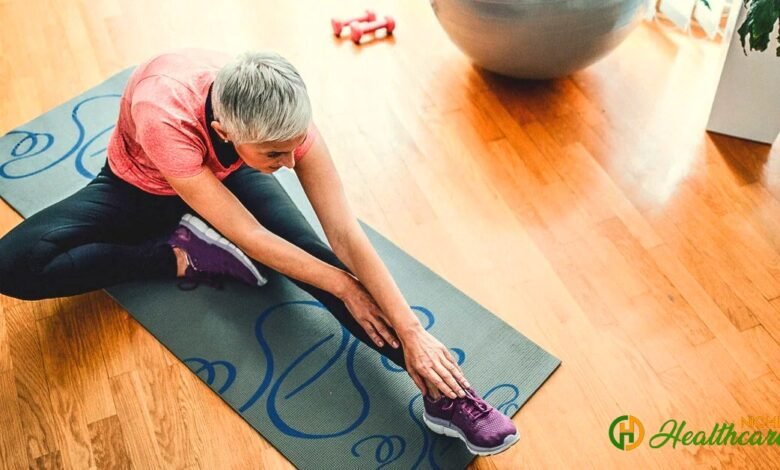How to Exercise Safely with Arthritis in 2023

Arthritis is a condition characterized by joint inflammation, leading to pain, stiffness, and reduced mobility. It affects millions of people worldwide, and its impact on daily life can be significant. Despite these challenges, engaging in regular exercise can bring numerous benefits to individuals with arthritis.
This comprehensive guide, on how to exercise safely with arthritis in 2023, enables you to take control of your health, manage your symptoms, and enjoy the benefits of an active lifestyle.
Read More: 9 Best Natural Ways to Reduce Arthritis Pain
Understanding Arthritis and Its Types
Arthritis is a condition characterized by joint inflammation, causing pain, stiffness, and limited mobility. It affects millions of people worldwide and can be categorized into different types. The most common types include osteoarthritis, rheumatoid arthritis, and gout. Osteoarthritis is caused by wear and tear of the joint cartilage, while rheumatoid arthritis is an autoimmune disease that affects the joints. Gout, on the other hand, results from the buildup of uric acid crystals in the joints.
Benefits of Exercise for Arthritis

Regular exercise offers numerous benefits for individuals with arthritis. Exercise helps to reduce pain, strengthen muscles surrounding the joints, improve joint flexibility, and enhance overall physical and mental well-being. By engaging in appropriate exercises, individuals with arthritis can enjoy increased joint mobility, reduced stiffness, and a better quality of life.
Consulting with a Healthcare Professional
Before starting an exercise routine, it’s crucial to consult with a healthcare professional, such as a rheumatologist or a physical therapist. These professionals can assess your individual needs, provide personalized guidance, and recommend exercises suitable for your specific condition. They can also help monitor your progress and make adjustments as needed.
Choosing the Right Exercises
When selecting exercises for arthritis, it’s important to focus on low-impact activities that minimize stress on the joints. Walking, swimming, and cycling are excellent options that provide cardiovascular benefits without putting excessive strain on the joints. Additionally, strength training exercises help to build muscle, which provides better joint support. Flexibility exercises, such as yoga or tai chi, can improve joint range of motion and reduce stiffness.
Modifying Exercise Routine for Arthritis
It’s crucial to adapt exercises to accommodate arthritis symptoms and limitations. Start slowly and gradually increase the intensity and duration of your workouts. If you experience joint pain or discomfort during an exercise, modify the movement to reduce stress on the joints. For example, if squats cause knee pain, try using a stability ball against a wall to perform partial squats. Listening to your body and making necessary adjustments will help you exercise safely and avoid unnecessary strain.
Warm-Up and Cool-Down
Before starting any exercise session, it’s essential to warm up the muscles and joints to prevent injury. Begin with gentle range-of-motion exercises or light cardiovascular activities, such as brisk walking or marching in place. After the exercise session, take the time to cool down by performing static stretches. This helps to gradually lower your heart rate and reduce muscle soreness.
Managing Pain and Discomfort
If you experience pain or discomfort during exercise, there are strategies to manage it effectively. Applying heat or cold therapy to the affected joints before and after exercise can provide relief. The heat helps to relax muscles and increase blood flow, while cold therapy reduces inflammation. Over-the-counter pain-relief medications, such as acetaminophen or nonsteroidal anti-inflammatory drugs (NSAIDs), may also be helpful. However, it’s important to consult with your healthcare professional before using any medications.
Listening to Your Body
When exercising with arthritis, it’s crucial to listen to your body’s cues. Pay attention to how your joints feel during and after exercise. If you experience increased pain, swelling, or persistent fatigue, it may be a sign that you need to modify your routine or take a break. Pacing yourself and allowing for rest periods can prevent overexertion and minimize the risk of joint damage.
Staying Motivated and Consistent
Maintaining a regular exercise routine can be challenging, but it’s essential for managing arthritis effectively. Set realistic goals and track your progress to stay motivated. Celebrate small achievements along the way to maintain enthusiasm. Finding a workout buddy or joining an arthritis exercise class can also provide support and accountability. Remember, consistency is key to reaping the long-term benefits of exercise.
Other Considerations
While exercise is beneficial, it’s important to support your workouts with a healthy lifestyle. Proper nutrition and hydration play a crucial role in maintaining overall joint health. A well-balanced diet rich in fruits, vegetables, lean proteins, and whole grains provides essential nutrients for joint repair and inflammation reduction. Staying hydrated helps to keep joints lubricated and aids in the removal of waste products from the body.
Additionally, wearing appropriate footwear is important to support your joints and minimize the risk of injury. Opt for well-cushioned shoes that provide stability and shock absorption. In some cases, using assistive devices like braces, splints, or canes may be necessary to reduce joint stress during exercise. Consult with your healthcare professional for guidance on using such devices.
Exercise Precautions
While exercise is generally safe for individuals with arthritis, certain precautions should be taken. Avoid high-impact activities like running or jumping, as they can put excessive strain on the joints. Additionally, avoid exercises that cause pain or discomfort. If you experience redness, swelling, or severe pain in your joints during or after exercise, it’s important to seek medical attention promptly.
Overcoming Barriers to Exercise
Fatigue, fear of worsening symptoms, or lack of motivation can act as barriers to exercise for individuals with arthritis. To overcome these challenges, it’s important to listen to your body, start slowly, and gradually increase the intensity and duration of your workouts. Prioritize rest and recovery to avoid burnout. If you find it difficult to exercise alone, seek support from friends, family, or local support groups. They can provide encouragement and make exercising more enjoyable.
Joining Supportive Communities
Joining support groups or participating in physical activity programs specifically designed for individuals with arthritis can provide valuable support and motivation. These communities offer opportunities to connect with others who share similar experiences and challenges. They often provide expert guidance, educational resources, and a safe space to discuss concerns and triumphs. Online platforms, social media groups, and local community centers can help you find these supportive communities.
Conclusion
Exercising safely with arthritis in 2023 is an essential aspect of managing the condition and improving overall well-being. By understanding the types of arthritis, consulting with healthcare professionals, choosing appropriate exercises, and modifying routines as needed, individuals with arthritis can enjoy the benefits of exercise while minimizing pain and discomfort. Remember to listen to your body, stay motivated, and prioritize your long-term health. Together, exercise and arthritis can coexist harmoniously, supporting a more active and fulfilling life.
Read More: Do You Need Medical Attention for Back or Neck Pain
FAQs
Can I exercise with arthritis if I have limited mobility?
Yes, absolutely. Even individuals with limited mobility can engage in exercises suitable to their abilities. Low-impact activities like water aerobics or seated exercises can be beneficial. Consult with a physical therapist who can guide you in designing a personalized exercise routine that accommodates your mobility limitations.
Is it safe to lift weights or engage in strength training with arthritis?
Yes, strength training can be beneficial for individuals with arthritis. However, it’s important to use proper form, start with lighter weights, and gradually increase the resistance. Focus on exercises that target the major muscle groups surrounding the affected joints. Consult with a physical therapist or certified trainer to learn appropriate techniques.
Can I exercise during an arthritis flare-up?
During an arthritis flare-up, it’s generally best to give your joints a rest and avoid exercises that exacerbate pain or inflammation. Focus on gentle range-of-motion exercises and stretching to maintain joint mobility. Once the flare-up subsides, gradually reintroduce low-impact exercises and consult with your healthcare professional for guidance.
Are there any specific exercises to avoid if I have arthritis?
While exercise is beneficial, certain exercises can be challenging for individuals with arthritis. High-impact activities like running or jumping can place excessive stress on the joints. Additionally, exercises that involve repetitive motions or excessive joint twisting, such as certain yoga poses, may be less suitable. It’s important to listen to your body and avoid any exercises that cause pain or discomfort.
Can swimming be beneficial for arthritis?
Swimming and water-based exercises are often recommended for individuals with arthritis due to the buoyancy of the water, which reduces joint stress. The water’s resistance also provides a low-impact strength-training workout. Swimming and water aerobics can help improve joint mobility, strengthen muscles, and provide overall cardiovascular benefits.







